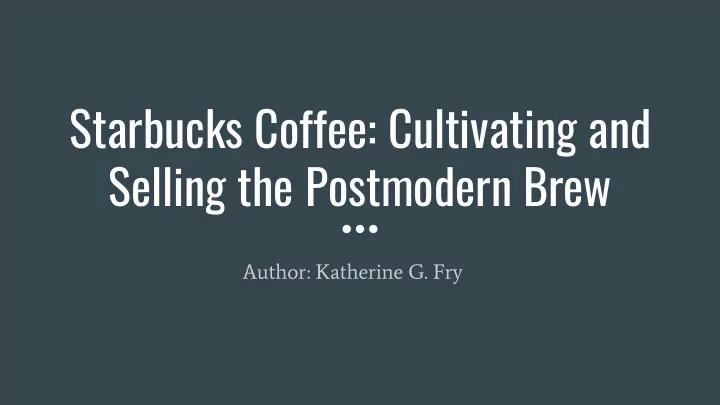

Starbucks Coffee: Cultivating and Selling the Postmodern Brew Author: Katherine G. Fry
Summary Through the example of a Starbucks ad featuring a man from New Guinea in the 1992 issue of Sunset magazine and the image of Juan Valdez for Colombian coffee, Fry discusses the widely used incorporation of the “exotic and mystic” other in advertising and marketing to appeal to the “New Age mysticism” of many American consumers .
● How did Starbucks coffee rise so quickly from obscurity to near-ubiquity in the late 1990s in the United States? ● Transformation of capitalism
“The ad freezes this culture in the past and, referring to the forces of nature and myth, regulates New Guinea and its native peoples to another era, less developed than that of the implied Sunset Readership.”
“To appropriate the images of racial, ethnic, and even gender difference in advertising is what John Urry calls constructing the tourist gaze.” “As a sales tool, the image is appealing. It works, but it is a lie.”
“Because he has been photographed at such an intimate distance he is vulnerable to semiotic exploitation.”
Habitus Is the term French sociologist Pierre Bourdieu uses to describe the ● taste structures of class fractions “It is the unconscious, or naturalized, system of rules dictating ● food, clothing, product, entertainment, and other lifestyle choices made within class-based groupings.” Bourdieu examines the significance of taste as a marker of social ● class He argues that among classes with the most economic and cultural ● capital, items and practices are divorced from their function and advertising is lifestyle-oriented. Different choice are made by different class fractions ●
“None of my research on New Guinea has led me to a tribe or peoples called Konmei. Neither have I found the term used in any context, as a name or label, associated with the people of New Guinea. ” - The ignorance is dangerous
“New Guinea, a small country colonized much later than Colombia, is still a mystery to most Americans. Therefore, in the effort to market its produce, native New Guinea culture can be readily appropriated, recast, and even transformed, to appeal to the desires of the right market niche.”
John Urry “The maintenance of a class based system via symbolic lifestyle choices along the lines of class, race, and geography.” Tourist gaze- Urry’s concept regarding the upper class travels to new places and consuming them visually through picturing taking and physically through their consumptive presence on the land. - Urry and Boorstin argue that a tourists’ desire to consume is the motivation for their travels.
OBJECTIFIED V. OBJECTIFIER ?
“One need not physically travel to exotic places in order to gaze upon the exotic other. The mass media and advertising, he argues, act as culture’s mediaries, contributing enormously to our ability - through photographs, video and film - endlessly to reproduce and visually consume the other.”
● Article about traveling to new guinea is “ a straightforward offer of exchange to the reader; the nearby Starbucks ad, in comparison, veils the commodity exchange by mystifying both the culture and the coffee bean.”
● images/photos - the object of our gaze and a sales tool ● Companies words reinforces their image, not reality. For instance, Starbucks and their community goodwill and promise of small, personal business even though it’s a corporate chain all over.
Andrew Wernick Promotional culture or culture of commodification. ● “He is describing a condition wherein all mass- and many non-mass-media messages, produced goods, and even human actions aim to ‘sell’ in some way.” - All of these choices have a homogenizing effect. Illusion of choice, and these choices are all structured for us from a predetermined menu of items all not inherently different but are promoted different to us. - Extravagant expectations - we expect more than can be given to us - Logic of promotion is that images can create choice/illusion of choice
Starbucks controversy: ● “ In 2006, the Ethiopian government attempted to trademark regional coffees such as Sidamo and Harar because these specialty brews sell for up to $26 a pound, with only about $1 getting back to the Ethiopian coffee farmers. Starbucks, working through the National Coffee Association, blocked Ethiopia’s trademark bid, helping ensure the continuation of poverty in an already impoverished region.”
1. Starbucks retail success is only one example of the logic of capitalism that Fry points out, can you think of any others? 2. What do you think of her discussion on the illusion of choice? 3. What are some problems with the logic of promotion? (How a brand or ad can make you think you’ve experienced another culture/adventure?)
Recommend
More recommend